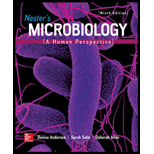
Nester's Microbiology: A Human Perspective
9th Edition
ISBN: 9781259709999
Author: Denise G. Anderson Lecturer, Sarah Salm, Deborah Allen
Publisher: McGraw-Hill Education
expand_more
expand_more
format_list_bulleted
Textbook Question
Chapter 5, Problem 9SA
How is an iodophore different from a tincture of iodine?
Expert Solution & Answer
Want to see the full answer?
Check out a sample textbook solution
Students have asked these similar questions
evolutionary analysis
Can I get this answered with the colors and what type of connection was formed? Hydrophobic, ionic, or hydrogen.
Can I please get this answered with the colors and how the R group is suppose to be set up. Thanks
Chapter 5 Solutions
Nester's Microbiology: A Human Perspective
Ch. 5 - How is preservation different from pasteurization?Ch. 5 -
2. What is the most chemically resistant...Ch. 5 - Explain why it takes longer to kill a population...Ch. 5 - What is the primary reason that wine is...Ch. 5 -
5. What is the primary reason that milk is...Ch. 5 - When canning, why are low-acid foods processed at...Ch. 5 - How are heat-sensitive liquids sterilized?Ch. 5 -
8. How does microwaving a food product kill...Ch. 5 -
9. How is an iodophore different from a tincture...Ch. 5 - Name two products commonly sterilized using...
Ch. 5 - Unlike a disinfectant, an antiseptic a) sanitizes...Ch. 5 - The D value is defined as the time it takes to...Ch. 5 - Prob. 3MCCh. 5 - Prob. 4MCCh. 5 - Which concentration of alcohol is the most...Ch. 5 - All of the following could be used to sterilize an...Ch. 5 - All of the following are routinely used to...Ch. 5 - Aseptically boxed juices and cream containers are...Ch. 5 - Commercial canning processes are designed to...Ch. 5 -
10. Which of the following is false?
a) A...Ch. 5 - An agriculture extension agent is preparing...Ch. 5 - As a microbiologist representing a food...Ch. 5 - This graph shows the time it takes to kill...Ch. 5 -
2. This diagram shows the filter paper method...
Knowledge Booster
Learn more about
Need a deep-dive on the concept behind this application? Look no further. Learn more about this topic, biology and related others by exploring similar questions and additional content below.Similar questions
- fa How many different gametes, f₂ phenotypes and f₂ genotypes can potentially be produced from individuals of the following genotypes? 1) AaBb i) AaBB 11) AABSC- AA Bb Cc Dd EE Cal bsm nortubaarrow_forwardC MasteringHealth MasteringNu × session.healthandnutrition-mastering.pearson.com/myct/itemView?assignment ProblemID=17396416&attemptNo=1&offset=prevarrow_forward10. Your instructor will give you 2 amino acids during the activity session (video 2-7. A. First color all the polar and non-polar covalent bonds in the R groups of your 2 amino acids using the same colors as in #7. Do not color the bonds in the backbone of each amino acid. B. Next, color where all the hydrogen bonds, hydrophobic interactions and ionic bonds could occur in the R group of each amino acid. Use the same colors as in #7. Do not color the bonds in the backbone of each amino acid. C. Position the two amino acids on the page below in an orientation where the two R groups could bond together. Once you are satisfied, staple or tape the amino acids in place and label the bond that you formed between the two R groups. - Polar covalent Bond - Red - Non polar Covalent boND- yellow - Ionic BonD - PINK Hydrogen Bonn - Purple Hydrophobic interaction-green O=C-N H I. H HO H =O CH2 C-C-N HICK H HO H CH2 OH H₂N C = Oarrow_forward
- Find the dental formula and enter it in the following format: I3/3 C1/1 P4/4 M2/3 = 42 (this is not the correct number, just the correct format) Please be aware: the upper jaw is intact (all teeth are present). The bottom jaw/mandible is not intact. The front teeth should include 6 total rectangular teeth (3 on each side) and 2 total large triangular teeth (1 on each side).arrow_forward12. Calculate the area of a circle which has a radius of 1200 μm. Give your answer in mm² in scientific notation with the correct number of significant figures.arrow_forwardDescribe the image quality of the B.megaterium at 1000X before adding oil? What does adding oil do to the quality of the image?arrow_forward
- Which of the follwowing cells from this lab do you expect to have a nucleus and why or why not? Ceratium, Bacillus megaterium and Cheek epithelial cells?arrow_forward14. If you determine there to be debris on your ocular lens, explain what is the best way to clean it off without damaging the lens?arrow_forward11. Write a simple formula for converting mm to μm when the number of mm's is known. Use the variable X to represent the number of mm's in your formula.arrow_forward
- 13. When a smear containing cells is dried, the cells shrink due to the loss of water. What technique could you use to visualize and measure living cells without heat-fixing them? Hint: you did this technique in part I.arrow_forward10. Write a simple formula for converting μm to mm when the number of μm's are known. Use the variable X to represent the number of um's in your formula.arrow_forward8. How many μm² is in one cm²; express the result in scientific notation. Show your calculations. 1 cm = 10 mm; 1 mm = 1000 μmarrow_forward
arrow_back_ios
SEE MORE QUESTIONS
arrow_forward_ios
Recommended textbooks for you
 Principles Of Radiographic Imaging: An Art And A ...Health & NutritionISBN:9781337711067Author:Richard R. Carlton, Arlene M. Adler, Vesna BalacPublisher:Cengage Learning
Principles Of Radiographic Imaging: An Art And A ...Health & NutritionISBN:9781337711067Author:Richard R. Carlton, Arlene M. Adler, Vesna BalacPublisher:Cengage Learning



Principles Of Radiographic Imaging: An Art And A ...
Health & Nutrition
ISBN:9781337711067
Author:Richard R. Carlton, Arlene M. Adler, Vesna Balac
Publisher:Cengage Learning



Biochemical Tests-Part 1; Author: Southern Stacker;https://www.youtube.com/watch?v=a-i9vANfQWQ;License: Standard Youtube License